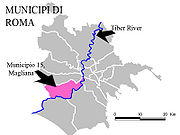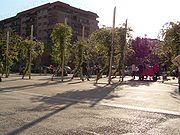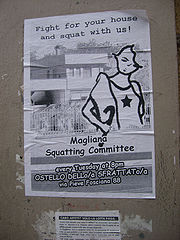
Magliana
Encyclopedia

House
A house is a building or structure that has the ability to be occupied for dwelling by human beings or other creatures. The term house includes many kinds of different dwellings ranging from rudimentary huts of nomadic tribes to free standing individual structures...
is made up of mostly owner-occupied apartments in 7-8 story apartment buildings.

The neighborhood is confined by the Tiber River on the East and Railroad tracks on the West edge.
In the center of Magliana there are two main areas of congregation: Piazza Fabrizio De Andre and the Mercato Magliana (Magliana Market). The Piazza Fabrizio De Andre is consistently filled with people; in the morning the older generation can be seen sitting on the many benches or strolling through. In the afternoon through early evening it is usually filled with more than 60 children playing on the playground
Playground
A playground or play area is a place with a specific design for children be able to play there. It may be indoors but is typically outdoors...
equipment. The Mercato Magliana is open in the morning and early afternoon and offers a wide variety of goods at discount prices.
History
Magliana began as an informal settlement taken over by migrants from other parts of ItalyItaly
Italy , officially the Italian Republic languages]] under the European Charter for Regional or Minority Languages. In each of these, Italy's official name is as follows:;;;;;;;;), is a unitary parliamentary republic in South-Central Europe. To the north it borders France, Switzerland, Austria and...
. The engineer Michelangelo Bonelli was the owner during this time period of illegal settlement. As the population began to grow, the lack of basic necessities became more evident. Homes did not contain running water nor sewage
Sewage
Sewage is water-carried waste, in solution or suspension, that is intended to be removed from a community. Also known as wastewater, it is more than 99% water and is characterized by volume or rate of flow, physical condition, chemical constituents and the bacteriological organisms that it contains...
systems. In addition, the residents lived in increasingly crowded conditions as the population grew.
In 1931, the government drafted and later implemented the Piano de 1931 (Comitato di Quartiere, 1977). Even though Magliana contained a high concentration of people living in poverty
Poverty
Poverty is the lack of a certain amount of material possessions or money. Absolute poverty or destitution is inability to afford basic human needs, which commonly includes clean and fresh water, nutrition, health care, education, clothing and shelter. About 1.7 billion people are estimated to live...
, the government chose to develop EUR
Esposizione Universale Roma
EUR is a residential and business district in Rome, Italy, located south of the city center. The area was originally chosen in 1930s as the site for the 1942 world's fair which Benito Mussolini planned to open to celebrate twenty years of Fascism. EUR was also designed to direct the expansion of...
instead of Magliana. The government ignored the underprivileged and underdeveloped state of Magliana and its residents, which enraged the community. Eventually, speculators eventually gained control of the area. Abusivismo, or speculators constructing buildings without abiding by building regulations
Building regulations
Building regulations may refer to:*Building code, a set of rules that specify the minimum acceptable level of safety for constructed objects*Building regulations in the United Kingdom, statutory instruments that seek to ensure that the policies set out in the Building Act 1984...
, resulted from this, meaning that speculators constructed buildings without abiding by building regulations. This led to the construction of buildings located below river level. These buildings violated construction regulations because due to the threat of possible flooding. Many apartment complexes remain illegal due to their location and lack of modification to accommodate the natural environment
Natural environment
The natural environment encompasses all living and non-living things occurring naturally on Earth or some region thereof. It is an environment that encompasses the interaction of all living species....
.
Community Activism
Magliana was historically an underserviced community that has fought to receive fair treatment from city and municipal authorities. Because Magliana was created by speculators in the 1970s in violation of construction regulations, it was not connected to city water, electricity, and sometimes power lines. Open spaces, sidewalks and roads were poorly maintained as well.
Lobbying
Lobbying is the act of attempting to influence decisions made by officials in the government, most often legislators or members of regulatory agencies. Lobbying is done by various people or groups, from private-sector individuals or corporations, fellow legislators or government officials, or...
and protested, demanding that their neighborhood be incorporated into greater Rome. The Comitato dei Quartieri della Magliana played a critical role in organizing residents. During the 1970s, they even published a community newsletter.
Another area of activisim in Magliana concerned eviction
Eviction
How you doing???? Eviction is the removal of a tenant from rental property by the landlord. Depending on the laws of the jurisdiction, eviction may also be known as unlawful detainer, summary possession, summary dispossess, forcible detainer, ejectment, and repossession, among other terms...
s. Many of Magliana’s residents were unprivileged during the 1970s. Landlords would demand unmanageable rents from residents, even though apartments were sometimes not connected to water and telephone lines. Residents organized to halt evictions by developing strong networks, informing each other of pending evictions, and on the day of the intended evictions, they would telephone each other when the police
Police
The police is a personification of the state designated to put in practice the enforced law, protect property and reduce civil disorder in civilian matters. Their powers include the legitimized use of force...
entered the neighborhoods and residents would gather in the streets and physically prevent police from entering the neighborhood. As a result of this activism
Activism
Activism consists of intentional efforts to bring about social, political, economic, or environmental change. Activism can take a wide range of forms from writing letters to newspapers or politicians, political campaigning, economic activism such as boycotts or preferentially patronizing...
, fewer evictions occurred in Magliana over time.
Though the amount of activist activity in Magliana has decreased since the 1970s, there is still a significant amount of community organizing
Community organizing
Community organizing is a process where people who live in proximity to each other come together into an organization that acts in their shared self-interest. A core goal of community organizing is to generate durable power for an organization representing the community, allowing it to influence...
. There are squatter settlements in Magliana which house people who for whatever reason are not able to obtain housing. These are primarily run by communist and socialist organizations.
On the more organized end of the spectrum, the Comitato di quartieri still holds activities. They also teach an Italian language
Italian language
Italian is a Romance language spoken mainly in Europe: Italy, Switzerland, San Marino, Vatican City, by minorities in Malta, Monaco, Croatia, Slovenia, France, Libya, Eritrea, and Somalia, and by immigrant communities in the Americas and Australia...
class for immigrants two days a week.
See also
- Administrative subdivision of Rome#Municipi
- Roma, Italy
- Lucca, Italy
- Siena, Italy

